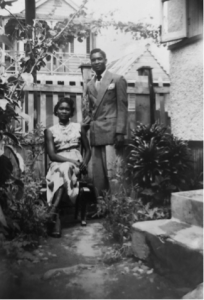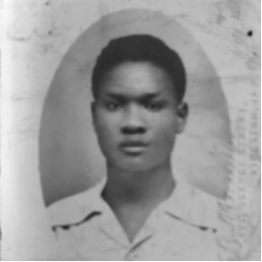
PhD student Elli Michaela Young introduces her research project

Fig. 1 Barrington and Teresa Young, Whitfield Town, Kingston Jamaica, circa 1950. Photographer unknown.
Jamaicans have often engaged with fashion and textiles in complex ways in order to navigate their complex social landscape. Yet Jamaica’s contribution to global fashion and textile histories and to fashion has often been overlooked, and in some cases forgotten. My PhD project, entitled ‘Fashioning Jamaica 1950-1975’, seeks to uncover hidden histories in order to tell a story about the ways that fashion and textiles have been used in the construction of Jamaican identities, both internally and externally. Part of this looks at how Jamaicans used fashion to navigate their colonial landscape. Another element looks at how the Jamaican government used fashion and textiles to construct an identity for a global fashion market in postcolonial Jamaica. I have encountered numerous difficulties researching under-represented areas such as fashion and textiles in Jamaica, which has meant I have had to redesign my project. Documents relating to the industry have not been kept, documented or have been destroyed, both in Jamaica and outside, making it difficult to fully document their contribution to global fashion. This has resulted in one of my most important research activities becoming identifying and collecting photographs that relate Jamaican fashion and Jamaican designers. This is not always an easy task and particularly when those images are held in archives outside of the UK; either in Jamaica and North America, or stored in personal family photo albums.
For my project I am drawing on photography, oral histories, and life stories to help me tell the story of Jamaicans’ relationship with fashion. I was fortunate to have a father with an interest in photography and so have a collection of photographs that I have been able to use for my project. Photography was not easily accessible to many Jamaicans during the 1940s and 50s, but photography was an important part of constructing his identity. Many Jamaicans would often have their photographs taken in studios, but my father (figure 1) took photography out of the studio, carefully staging each image in specific locations. The only image I have of my father taken in a studio is his passport photograph (figure 2) taken when he was approximately 18 years of age. Barrington was not the only person in his family to use photography in this way. Figure 3 is of Barrington’s sister, Gloria Young, who was a freehand dressmaker and made all of her own clothes. She made the clothes she wears in this image. Freehand dressmaking was a popular practice in colonial Jamaica. It is a practice that allowed dressmakers creative license, allowing them to create individual one-off designs. An individuality that, for some Jamaicans, was an important part of constructing their identities. Figure 4 is of his sister Theresa, taken in the garden of the family home. The way Barrington and his sisters engaged with photography suggests they had an understanding of the power of photography in documenting their lives and controlling the way they were seen and would be remembered, particularly as these photographs are the only record of their lives during this period.
As a Design Star student, I have been fortunate to receive funding for research trips to Jamaica (both from Design Star and the Design History Society), which have allowed me to visit a number of archives in Jamaica. The National Library of Jamaica and The Gleaner Archive in Kingston have been especially important to my project. Researching in locations like Jamaica is a good experience: often you may not find what you are looking for, which can disappoint, but you will find material you didn’t expect that makes you think about your research in a very different way. What I, as British researcher, thinks of as important is not necessarily viewed in the same way as those who are Jamaican and documenting their own history, a position that has forced me to rethink my approach and to rethink entire sections of my project. Researching in Jamaica has taught me to be open to challenges, to adapt and be willing to make changes to my research in order to allow Jamaicans to speak for themselves.



Great piece and really interesting work I just wanted to know if this final work / thesis is available online to view and read, I’d love to learn more about this project / journey undertaken and how it finished.
Thank you
Thank you for your comment, which I have passed directly to Elli Michaela Young, who I hope will be in touch with you directly.
Interesting project – I’m a photographer In NY my Jamaican gran was a very stylish business womankind dress maker ..I appreciate this project 😎🇯🇲
My grandmother is a dressmaker as well- and still enjoys doing it to this today! Fashion is a big part of her identity and she truly loves it. She makes beautiful clothing. Thank you for sharing your project. I hope you get to do more fascinating research!